PENRHYN
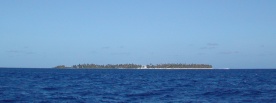
Penrhyn is an atoll 12.5 miles long in a SE-NW direction and about 8 miles wide. It has only two villages and one small pearl farm. The main village, Omoka, is on the west (leeward) shore, and it has a population of about 350. The second village, Te Tautua, is on the east shore, and its population is 35. The pearl farm is on the northwest shore, and about 15 people live there.
We arrived Penrhyn at night, so we hove to until daylight. But at daybreak it was raining, and visibility was poor, so we dropped an anchor and planned to stay put till visibility improved. A few hours later a small aluminum fishing boat approached, and one of its occupants identified himself as the quarantine officer for the island. He offered to come aboard and guide us through the channel in the limited visibility. We towed his boat as we relied on his local knowledge of the pass. We were inside within half an hour, and we dropped our anchor in 40′ sand over coral with a lee shore about 40 yards behind us.
The quarantine officer left to get his paperwork, and when he returned he wanted to talk about what we had to trade. We advised him we brought nothing to trade, but he persisted. This was the first of our many unwanted trade experiences on Penrhyn.

Te Tautua – a beautiful anchorage
Both government officials and private citizens came by our boat asking what we had to trade. They boarded our boat uninvited, and they stayed late in to the evening (even when they knew we had not yet showered or slept after our long passage). They interrupted us when we had dinner guests, and they implied that we were lying when we told them that we did not have whatever it was that they wanted. We felt harassed, and we were growing increasingly uncomfortable.
We were also frustrated by the local bank. Government officials on Penrhyn will accept only New Zealand dollars, but the only bank on island will not exchange other currencies. They would not even cash a U.S. bank draft written in New Zealand dollars. We were referred to a kiwi that lives out at the airport as the only person that could exchange any money for us. We had no choice other than to accept his exchange rate, but at least we had enough money to pay our fees and leave if our discomfort continued. It worsened.

Nurse shark
The weather kicked up, and we had 30 knots of wind blowing us down on a lee shore with 3′ chop. We were very uncomfortable. We would have checked out and left except that we had some business pending, and we needed to remain near a fax machine. We didn’t know if we would find another fax until American Samoa, so we felt somewhat stuck. So we crossed the lagoon and anchored off the village of Te Tautua.
Te Tautua is a delightfully calm anchorage on the windward side of the lagoon, and we thought this would be a good place to hang out for a while. But as we were coming in, a small boat was literally circling us waiting to come aboard (uninvited) and trade.
The trade demands got so bad that they were dominating our experience, and this atmosphere complicated efforts at making friends. We were particularly troubled that this culture of trade has obviously been promoted by other cruisers. It does not reflect well on the community to which we choose to belong.
But we survived. In the end, despite the times of discomfort, we were able to distill out some good times and memories. A few of those…
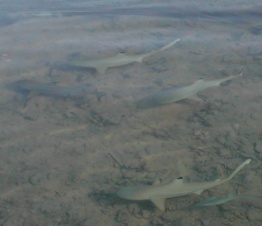
Blacktip sharks
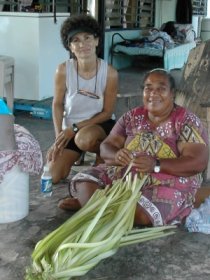
Processing coconut for weaving
The anchorage at Te Tautua was spectacular. We were in 25′ sand, and we had our own private little motu off our bow. We had a steady stream of black tip sharks around the boat. Most were about 4′. We had as few as five and as many as eleven at one time. There were also countless nurse sharks (some of them 7′) in the village, but they did not come out to the boat. It was beautiful.
We were befriended by Papa Situ and his wife, and they were delightful in their own ways. They shared their home and their table with us. They asked us for help with a few things, and they offered to help us any way they could. Good friends.
Papa Situ had a line of black pearl oysters break, and he asked us to dive to look for his oysters. As we sat in the boat about to dive in the shark-infested waters, he felt the need to pray. We were not comforted by this. But we did dive, and unfortunately we did not find his oysters. We did, however, find 6′ sharks – or did they find us?
Papa Situ took Bud fishing and lobstering. All expeditions were successful.
He also asked Bud to do some repair on his aluminum boats. It was a bit more involved than expected, but it got done. Bud also fixed a few solar panels and diagnosed a few sewing machines as terminal. Nita did a bit of sewing repairs to tarps/tents.
In return, we were given fish, bananas, bread fruit, and papaya. We were given some pearls, pearl shells, and some woven crafts. This is the type of trade we enjoy.
We also met an Aussie (married to a local women) – Mike – who runs the only pearl farm on Penrhyn. We hit it off well, and we spent a day at his place learning about the pearl industry. That was a very interesting day. Bud also dove on one of his pearl lines, but Nita sat it out.
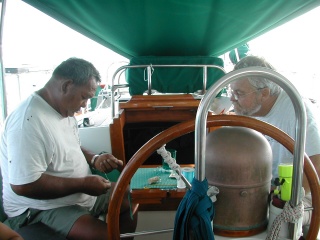
Tying fishing lures

Lobster
At the end of the day at the pearl farm, Mike was bringing us back to our boat. We were in his 22′ boat cruising along the coast when a 14″ mullet jumped in to the boat. Fish may be ‘brain food’, but they aren’t necessarily smart themselves. We ate him.
We had to go back to Omoka to finish up a little business and check out. We were pleased that we again got to visit with a young Aussie couple we had met a week earlier. Bud also had a few jobs to finish. He had promised to fix another solar panel and a fiberglass boat. All jobs completed!
In the end, Penrhyn was ok. We would not recommend it, and we would not go back, but we salvaged some good experiences there. It tested our resolve to look for the good wherever we go. We found a lot.
Read about our sailing within the Cook Islands.
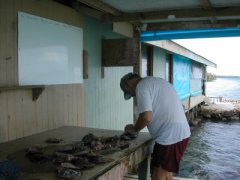
Bud opening black pearl oysters